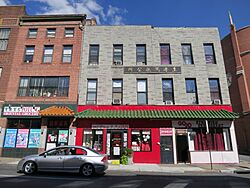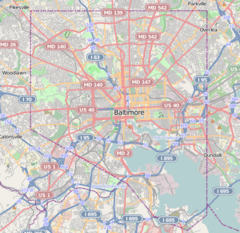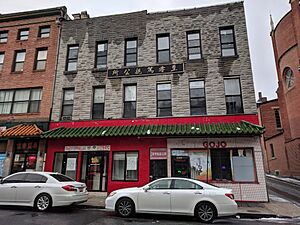Chinatown, Baltimore facts for kids
Quick facts for kids
Chinatown
|
|
|---|---|
|
Neighborhood
|
|

Chinese stores on Park Avenue
|
|
| Country | |
| State | Maryland |
| City | Baltimore |
| ZIP Code |
21201
|
| Area code(s) | Area code 410 |
Baltimore, Maryland, is home to a small area once known as Chinatown. Over time, Baltimore has had two main areas called "Chinatown." The first one was on Marion Street in the 1880s. The second and current location is on the 300 block of Park Avenue. This area was once full of Chinese laundries and restaurants.
The first Chinese people came to Baltimore because of the transcontinental railroad. However, the Chinese population in Baltimore never grew very large. By 1941, there were fewer than 400 Chinese residents. During a time when schools were separated by race, Chinese children were allowed to attend schools for white children.
Much of Chinatown changed after World War I due to city development. Even though the area was mostly safe during the difficult times of the 1960s, most Chinese residents moved to the suburbs. As of 2009, the area still showed signs of needing repair and did not have a traditional Chinese arch. By 2017, the neighborhood had become a new home for many Ethiopian people. In 2018, a special mural was painted. It showed a Chinese dragon and an African lion. This mural represents the area's past as Chinatown and its present as an African neighborhood. A night market in September 2018 was the first Asian celebration in this long-forgotten area.
Who Lives There?
According to the 2000 U.S. census, about 2,404 Chinese people lived in Baltimore. This was about 0.37% of the city's total population. The total Asian population in Baltimore was 9,985 at that time.
Chinatown's Story
The first Chinese residents might have arrived in Baltimore as early as the 1870s. However, official records confirm their presence by the 1880s. The very first Chinatown was on the 200 block of Marion Street. It was surrounded by Fayette Street, Park Avenue, Howard Street, and Lexington Street. After World War I, Chinatown moved. It went two blocks north to Park Avenue and Mulberry Street because the city was being redeveloped.
Baltimore was generally more welcoming to Chinese people than some other cities. Still, Chinese men and women often found it hard to get jobs outside of government work. Many worked in family-owned laundromats and restaurants. This situation led to some social connections with the Black community. During the difficult times of the 1960s, Chinese-owned businesses in Chinatown were mostly unharmed.
However, Chinatown still began to decline. Many Chinese residents moved away, mostly to the suburbs. A lot of them went to Washington D.C. and Rockville, Maryland.
From 1950 to 1970, a Chinese grocery and gift shop called Shang Wah Long Company was at 304-306 Park Avenue. It had moved from Mulberry Street and grew larger. The White Rice Inn, a Chinese restaurant, was at 320 Park Avenue. Other shops and several Chinese family associations were also on the 300 block of Park Avenue. Chinese food became more popular around town. New Chinese restaurants opened, like The Rice Inn, The Ho Joy Restaurant, The Rice Bowl, and Golden Star. Most of the cooking was in the "Cantonese" style.
During the time of Baltimore's Chinatown, people celebrated the Chinese Lunar New Year. This included a Chinese Dragon Dance, firecrackers, and giving out "Lucky Red Envelopes." Chinese movies were shown at the On Leong Association. Chinese language schools were also held there and at Grace and Saint Peters Episcopal Church.
By the 1970s, Baltimore's Chinatown was shrinking. It was losing its Chinese feel. Many plans were made to bring the neighborhood back to life. But the Park Avenue Chinatown almost disappeared. Only one Chinese restaurant, "The Chinatown Café," remained. As of 2008, people were discussing whether to rebuild the old Chinatown on Park Avenue. Another idea was to build a new one about a mile north at Charles Street and North Avenue. By 2009, the Chinatown Café was replaced by a new Chinese restaurant called "Zhongshan."
Why Did People Come?
Chinese settlers came to Baltimore for several reasons. One big reason was moving from the West Coast to the East Coast. This move was encouraged by the completion of the Transcontinental railroad. After finishing their work in the West around 1869, many Chinese laborers, who made up almost 80 percent of the railroad construction workers, traveled east. They looked for new jobs in cities like New York, Philadelphia, and Boston.
Another reason for moving east was the unfriendly feelings towards Chinese people on the West Coast. This was especially true in places like San Francisco. These feelings grew worse during an economic downturn in the late 1860s. Laws and courts often did not protect this minority group. Many Chinese people fled eastward to escape unfair treatment and difficult situations. Baltimore, being a coastal city and once a very busy port, welcomed European immigrants. It offered a place where people felt safer.
Most early Asian settlers did not arrive in Baltimore by ship. Instead, they came by train from the West Coast. Baltimore had a reputation as a welcoming place for international visitors. This encouraged thousands of Chinese immigrants to settle in the city.



